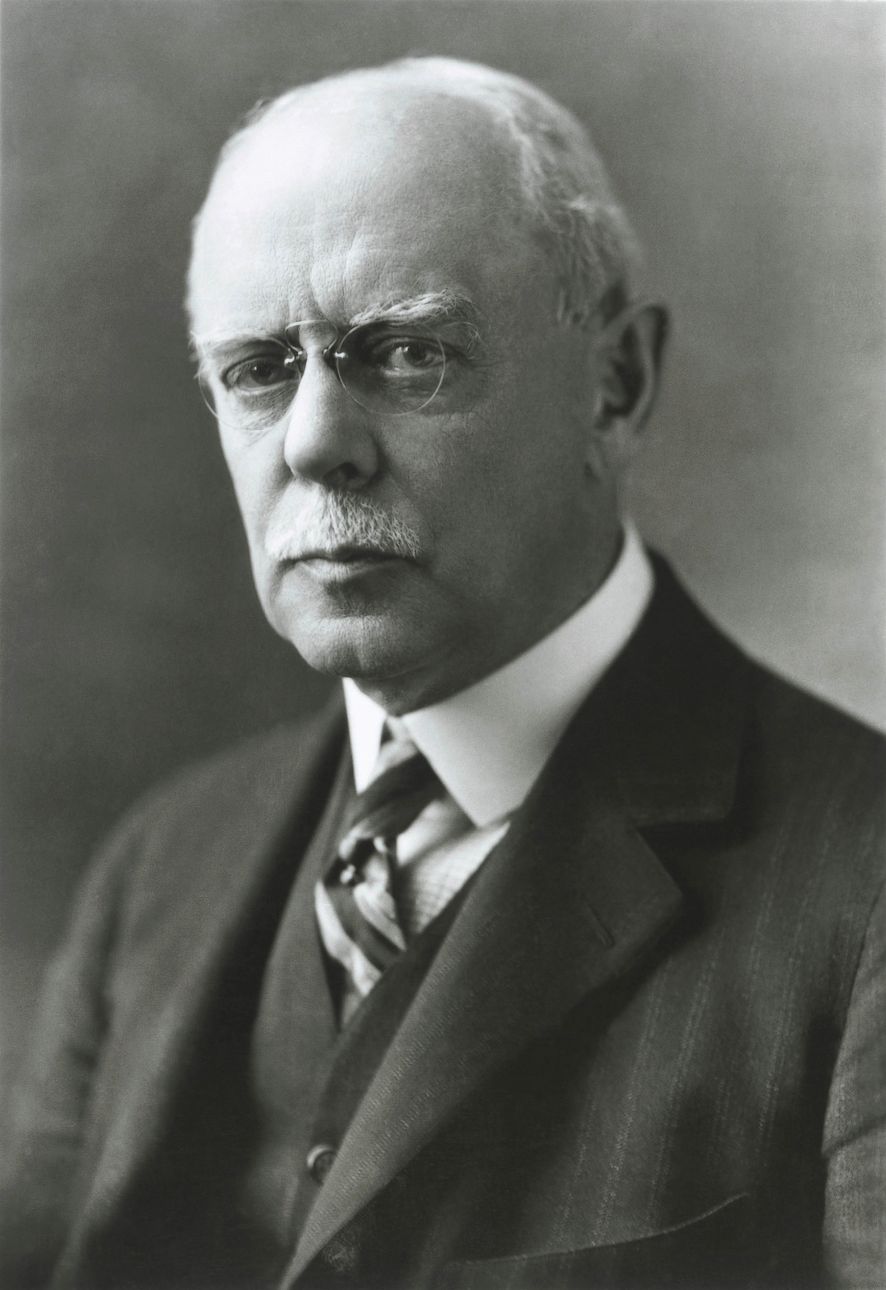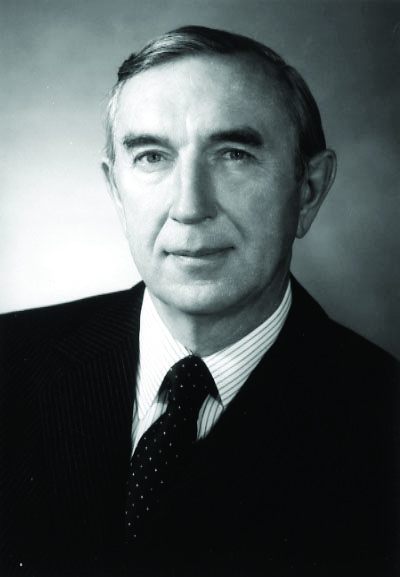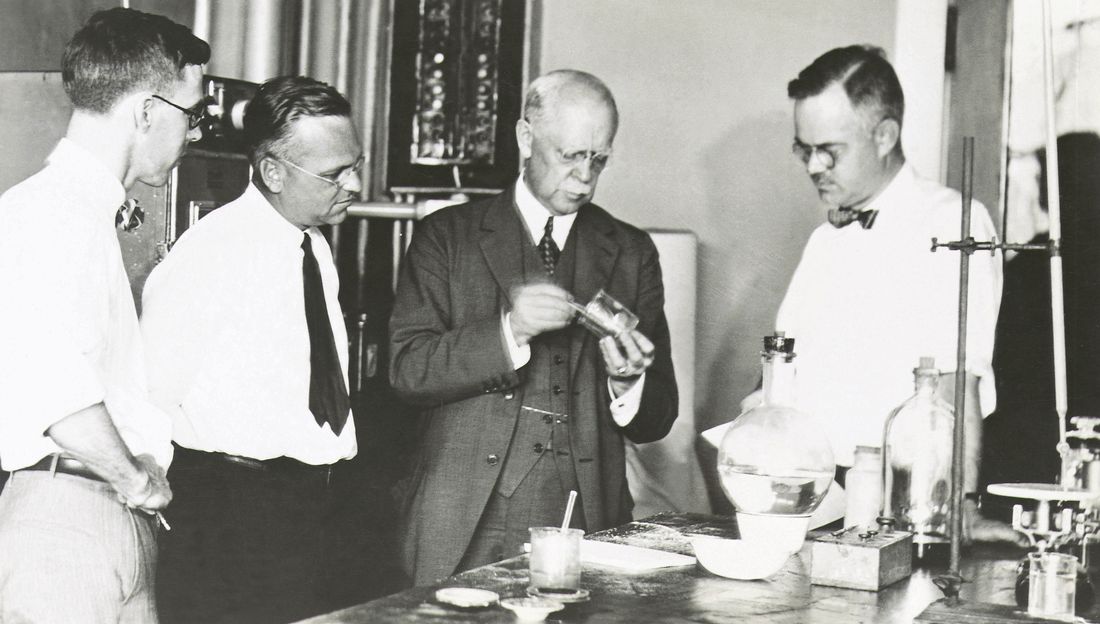DOWNLOAD
12 min read
Inventors, innovators, pathfinders
Celebrating the people behind ADLs remarkable journey through the 20th century and beyond.

Arthur D. Little is a company built on the singular vision and dedication of the man whose name it bears and his conviction that the application of the scientific method could revolutionize business. However, while Arthur Dehon Little remained the driving force behind the company right up until his death in 1935, he was supported in his endeavor by a team of hugely talented individuals, all of whom were pathfinders in their own right, as ADL strove to change the way that industry worked.

This is a celebration of some of the extraordinary people who have both led ADL and pioneered its unique approach to consultancy, inventing new solutions and breaking down barriers along the way.
Earl Place Stevenson
When Arthur Dehon Little died in 1935, research guru Earl Place Stevenson succeeded him as President and quickly set about instilling the company with a more business-like and disciplined culture. As E.J.Kahn Jr. notes in The Problem Solvers (1986), his book on the history of ADL, “Stevenson was a no-nonsense man. When he became President, he insisted that all members of staff answer their own phones rather than use secretaries as buffers.” Stevenson decentralized the company, establishing divisions according to scientific areas and empowering them to make their own decisions. He also encouraged the company to adopt more innovative ways of working beyond routine analytical jobs.
Stevenson was a formidable research scientist and industrial chemist, with 24 patents to his name. Having become the company's research director at the age of just 26, his belief in the power of science to advance the frontiers of industry, and the importance of applied research, was absolute. He once said, "We have passed through a period of epoch-making discoveries; if we are to more completely realize their potentialities, our recourse is intensive research, wisely directed, adequately financed, and sustained in the face of obstacles."
During World War II, Stevenson helped to develop oxygen masks for high-altitude pilots. He was also made chief of the chemical engineering division of the National Defense Research Committee ≠ subsequently, he became chairman of the Ad Hoc Committee on Chemical and Biological Warfare, a US government advisory board that became known as the Stevenson Committee. One of its key recommendations was the consolidation of chemical and biological warfare projects at the US Army's Camp Detrick, where pioneering research into biocontainment and decontamination took place.
One of ADL's most noteworthy initiatives under Stevenson's presidentship was Operation Bootstrap in Puerto Rico, where the company created the world's first multifaceted industrial development program, encouraging investors to transfer or create manufacturing plants in the country. The success of this program made the cover of Time magazine, and it became the international model for economic recovery projects.
Raymond Stevens
Stevenson was succeeded as President by Raymond Stevens in 1956. Although also an experienced chemist, Stevens was primarily a salesman and was responsible for further broadening ADL's services beyond that of a chemical and analytical laboratory. Under his direction, the company expanded its operations into consulting on marketing, management, and international economic development. He once said, "We are quite willing to reform the world, but we insist on being realistic about everything we do. We are a profit-making organization."
Stevens joined ADL in 1920 and was the first editor of the Industrial Bulletin, a monthly journal for clients focused on thought leadership and emerging industry developments. One such area he helped to move ADL towards was the commercialization of operations research, a new discipline developed during WWII that applied scientific and mathematical techniques to administrative and business operations. Stevens viewed it as a way of attracting new clients to the company, and ADL's subsequent activities in areas such as telecommunications, IT, and financial systems can all be traced back to his enthusiasm for operations research.
Stevens was also instrumental in developing ADL's non-hierarchical, entrepreneurial culture, recognizing that innovation often flowed upwards from the bottom of an organization, driven by younger recruits inspired by new ideas. He wrote, "In research and development operations, there must be a dramatic emphasis on communication from the lower echelons upward. Free, often direct communication links between the younger, creative minds and the top-level planners are vital... Only an atmosphere that provides for a `bottom up' flow of communications can unlock the innovative contributions that these talented people, specially trained in great depth, can make toward corporate goals."
James Gavin
In 1960, Stevens became chairman of the executive committee and was succeeded as President by James Maurice Gavin, who had only recently joined the company in 1958 as a VP. A former US Army Lieutenant General, World War II paratroop veteran, and Commander of the 82nd Airborne Division, Gavin had been on the verge of becoming a four-star general prior to joining ADL. However, he had become disenchanted with the Pentagon and decided instead to move into the world of business.

Gavin raised the company's profile significantly, not least because of his own personal charisma and "star power". As Kahn notes in The Problem Solvers, "Gavin's arrival gave ADL a cachet it had not before enjoyed in that status-conscious community." Gavin would entertain potential clients with reminiscences about John F. Kennedy and Charles de Gaulle and "open doors that his associates sometimes found hard even to get near," such as simply putting a direct call in to NATO when a meeting was required.
However, Gavin had more to offer than just connections in high places. His final military role had been to supervise the army's research and development activities, and his distinctly international outlook saw the company further expand overseas, taking ADL from a $10M company focused mainly on US-based clients to a $70M organization with significant global impact. By the 1970s, ADL had been involved in hundreds of international projects, from reforming trade practices in Bangladesh to helping to computerize the Bank of Greece.
Another significant development under Gavin's presidentship was the launch of the Arthur D. Little Management Education Institute, the first management education program focused exclusively on training business managers from developing countries. Design milestones during his time in office included the NASDAQ stock exchange system, key experiments for the Apollo moon landing, and the word processor.
During 1961-1962, Gavin took a leave of absence to become Ambassador to France under President Kennedy. He stepped aside from his role as ADL's President in 1972 to become Chairman of the Board until his retirement in 1977.
John Magee
John Magee became the company's President in 1972, and its CEO in 1974. Magee had joined ADL in 1950 as a 23-year-old Harvard maths graduate, specifically to work on the operations research project that Raymond Stevens had initiated. Magee would become a key figure in the popularization of this particular branch of management theory and practice both within ADL and in the wider business world, going on to become President of the Operations Research Society of America.

Magee was a down-to-earth figure who favored a non-hierarchical, collaborative approach to business, which he once boldly characterized as a "lack of respect for authority." Tellingly, when asked about his time at the company, he replied, "First of all, we had fun. We were also very proud of our ethical standards. We did interesting and useful work through our ability to bring together teams of people." Magee was also the author of The Decision Tree (1964), a seminal guide to the visualization of the decision-making process in business.
One area of work that became increasingly important for ADL during Magee's presidentship was environmental safety, which he described as the third major part of the company's business, alongside management services and technology development. Increasingly, clients approached ADL to help them understand the third-party effects that their activities had on the world, and how to manage and control them. Pollution was becoming a serious issue, and companies needed proper audit processes in place to minimize the risk of accidents. ADL also worked with the Environmental Protection Agency to help it understand what was technically feasible in the various industries.
By the 1980s, Magee had steered the company to face an increasingly technological future, with ADL's primary focus now telecommunications, electronics, financial industries, and biotech. However, just like the company's presidents before him, right back to Arthur Dehon Little himself, Magee was concerned that the world's political, social, and economic systems weren't keeping up with the pace of change. As such, he believed that ADL still had an important role to play, helping businesses and governments alike to both understand and embrace the future.
Peter Glaser
ADL has been at the cutting edge of technology and innovation throughout its history, and so it’s no surprise that the company has employed and nurtured many visionaries and inventors over the years. Working predominantly in the area of space research and technology, Peter Glaser is one such figure. Joining in 1955, Glaser spent nearly all of his professional life at ADL, with research for the US Air Force into the effects of extremely high temperatures on airborne objects leading to involvement in the early space program. He created a thermometer that could measure the lunar temperature to a thousandth of a degree Fahrenheit and developed the Apollo 11 lunar laser ranging array to measure the distance between the earth and the moon.

However, Glaser's most audacious and far reaching proposal was for the development of solar power station satellites that could convert sunlight into microwave energy and transmit it back to earth. With climate change and sustainability now driving government and business policy, and with carbon-neutral solutions sought to provide clean energy, it's an idea whose time may yet come.
Another area of space research that Glaser applied himself to involved the practicalities of eating aboard spacecraft and investigating why astronauts' perception of odors and flavors seemed to change outside of the earth's atmosphere. This might seem a far cry from the harder end of scientific boundary pushing that ADL was associated with, but the company was also renowned for its expertise in food science and flavor classification based on its background in chemical analysis. One of its earliest stars was Ernest Crocker, who joined ADL in 1922 and went on to become known as
"the man with the million-dollar nose" due to his ability to detect nine thousand distinct odors just through his sense of smell. This impressive skill led to early contracts with firms including Coca-Cola and Lever Brothers.
Perhaps ADL's most celebrated taste and flavor expert of more recent times is Pamela Low. After graduating with a degree in microbiology in 1951, Low joined ADL and began working as a "flavorist". In the early 1960s, she was asked to develop the flavor for a new cereal from Quaker Oats. Taking inspiration from the butter and brown sugar sauce that her grandmother would serve over rice when she was a child, Low came up with a coating that had what she described as the "want-more-ishness" factor- and so Cap'n Crunch cereal was born. Launched in 1963, Cap'n Crunch quickly became one of the most popular cereals in America, loved by both kids and adults, and the coating's recipe has remained unchanged since its launch. Yet while Cap'n Crunch may be what Low will always be remembered for, it was only one of the hundreds of high-profile products she worked on during her 34 years at ADL.
Although ADL was founded in Boston, Massachusetts, and the first few decades of its success were based on working with predominantly American clients, the company quickly expanded into international territories in the post-war period, and today has its global HQ in Brussels, Belgium, with over 40 offices worldwide. Two figures in ADL's history who were particularly important in the company's overseas development are Harland Riker and Kamal Saad.
Riker was the driving force behind the company's pioneering management training program for emerging business leaders from Africa - this grew into ADL's Management Education Institute, which eventually became the HULT International Business School. During his more than three decades at ADL, Harland led the company's international expansion in Europe, the Middle East, Latin America, and Asia, opening and overseeing more than 20 offices worldwide and transforming the firm into a global consulting practice. He became President of ADL International in 1984.
Raised in Beirut, Lebanon, Saad joined ADL in June 1966 and spent 32 years at the consultancy in a wide variety of roles across Europe and the Middle East, helping shape the company during the 1970s and 1980s. He was instrumental in developing ADL's reputation for leadership in innovation, including co-authoring the seminal book, Third Generation R&D (1991). This described how to break down organizational barriers that traditionally isolated R&D from the rest of the company and ensure that R&D projects matched corporate goals.
Peter Scott-Morgan
As well as pioneering the application of science in the corporate world, ADL has been at the forefront of management theory and new ideas around the business organization. One of its brightest stars in this field is Peter Scott-Morgan, an expert in systems analysis and change management who wrote the book The Unwritten Rules of the Game (1994), an acclaimed and influential account of the hidden inner workings of both organizations and society.
With a background in industrial automation and robotics, Scott-Morgan joined ADL in 1986 and was made the company’s youngest-ever Junior Partner while still in his early thirties. Ten years later, he was made both a Senior Vice President and Chief Learning Officer, with his ideas about how companies really worked applied to many of ADL’s biggest clients, including Philips Consumer Electronics and British Petroleum. An “Unwritten Rules” assignment became a rite of passage among the company’s consultants on the basis that “once you’ve fed [the sensitive results] back to a CEO... and survived... then you can do anything.”

Scott-Morgan is a pioneer in other ways too. He and his partner, Francis Scott-Morgan, made history in 1993 by being formally accepted as an unmarried couple entitled to unlimited independent travel in and out of the USA, despite being the same gender. Thanks to ADL and its lawyers, this arrangement set a legal precedent and precipitated a change in US Immigration policy.
Peter and Francis made history again in 2005 when they became one of the first gay couples to legally enter into a civil partnership following a change in English law.
Despite being diagnosed with motor neuron disease in 2017, ScottMorgan has drawn on his knowledge of robotics and AI to not only survive his condition but, in his own words, "to thrive". He has launched the Scott-Morgan Foundation, an alliance of corporations and experts, to advance his vision of technological and human synergy, and also recently published a critically acclaimed memoir, PETER 2.0: The Human Cyborg.
ADL continues to nurture and employ exceptional people from around the world, whose talents are helping to shape the future direction of the company. Everyone is from a different background, yet they all share the same characteristics as the pathfinders before them: an entrepreneurial outlook; a disruptive, non-hierarchical attitude; a passion for invention and the "next thing"; and perhaps most importantly, a can-do, down-to-earth approach to working with both their clients and their colleagues.
Ultimately, and like all great companies, ADL's stature in the industry and its success in delivering innovative solutions and consultancy to its clients is based on the quality of its people. Time and again, ADL has pioneered the application of analytical research and science in business, and promoted new approaches to old problems, thanks to the vision and dedication of its remarkable leaders and staff. This is the ADL way, and long may it continue.


12 min read
Inventors, innovators, pathfinders
Celebrating the people behind ADLs remarkable journey through the 20th century and beyond.


Arthur D. Little is a company built on the singular vision and dedication of the man whose name it bears and his conviction that the application of the scientific method could revolutionize business. However, while Arthur Dehon Little remained the driving force behind the company right up until his death in 1935, he was supported in his endeavor by a team of hugely talented individuals, all of whom were pathfinders in their own right, as ADL strove to change the way that industry worked.

This is a celebration of some of the extraordinary people who have both led ADL and pioneered its unique approach to consultancy, inventing new solutions and breaking down barriers along the way.
Earl Place Stevenson
When Arthur Dehon Little died in 1935, research guru Earl Place Stevenson succeeded him as President and quickly set about instilling the company with a more business-like and disciplined culture. As E.J.Kahn Jr. notes in The Problem Solvers (1986), his book on the history of ADL, “Stevenson was a no-nonsense man. When he became President, he insisted that all members of staff answer their own phones rather than use secretaries as buffers.” Stevenson decentralized the company, establishing divisions according to scientific areas and empowering them to make their own decisions. He also encouraged the company to adopt more innovative ways of working beyond routine analytical jobs.
Stevenson was a formidable research scientist and industrial chemist, with 24 patents to his name. Having become the company's research director at the age of just 26, his belief in the power of science to advance the frontiers of industry, and the importance of applied research, was absolute. He once said, "We have passed through a period of epoch-making discoveries; if we are to more completely realize their potentialities, our recourse is intensive research, wisely directed, adequately financed, and sustained in the face of obstacles."
During World War II, Stevenson helped to develop oxygen masks for high-altitude pilots. He was also made chief of the chemical engineering division of the National Defense Research Committee ≠ subsequently, he became chairman of the Ad Hoc Committee on Chemical and Biological Warfare, a US government advisory board that became known as the Stevenson Committee. One of its key recommendations was the consolidation of chemical and biological warfare projects at the US Army's Camp Detrick, where pioneering research into biocontainment and decontamination took place.
One of ADL's most noteworthy initiatives under Stevenson's presidentship was Operation Bootstrap in Puerto Rico, where the company created the world's first multifaceted industrial development program, encouraging investors to transfer or create manufacturing plants in the country. The success of this program made the cover of Time magazine, and it became the international model for economic recovery projects.
Raymond Stevens
Stevenson was succeeded as President by Raymond Stevens in 1956. Although also an experienced chemist, Stevens was primarily a salesman and was responsible for further broadening ADL's services beyond that of a chemical and analytical laboratory. Under his direction, the company expanded its operations into consulting on marketing, management, and international economic development. He once said, "We are quite willing to reform the world, but we insist on being realistic about everything we do. We are a profit-making organization."
Stevens joined ADL in 1920 and was the first editor of the Industrial Bulletin, a monthly journal for clients focused on thought leadership and emerging industry developments. One such area he helped to move ADL towards was the commercialization of operations research, a new discipline developed during WWII that applied scientific and mathematical techniques to administrative and business operations. Stevens viewed it as a way of attracting new clients to the company, and ADL's subsequent activities in areas such as telecommunications, IT, and financial systems can all be traced back to his enthusiasm for operations research.
Stevens was also instrumental in developing ADL's non-hierarchical, entrepreneurial culture, recognizing that innovation often flowed upwards from the bottom of an organization, driven by younger recruits inspired by new ideas. He wrote, "In research and development operations, there must be a dramatic emphasis on communication from the lower echelons upward. Free, often direct communication links between the younger, creative minds and the top-level planners are vital... Only an atmosphere that provides for a `bottom up' flow of communications can unlock the innovative contributions that these talented people, specially trained in great depth, can make toward corporate goals."
James Gavin
In 1960, Stevens became chairman of the executive committee and was succeeded as President by James Maurice Gavin, who had only recently joined the company in 1958 as a VP. A former US Army Lieutenant General, World War II paratroop veteran, and Commander of the 82nd Airborne Division, Gavin had been on the verge of becoming a four-star general prior to joining ADL. However, he had become disenchanted with the Pentagon and decided instead to move into the world of business.

Gavin raised the company's profile significantly, not least because of his own personal charisma and "star power". As Kahn notes in The Problem Solvers, "Gavin's arrival gave ADL a cachet it had not before enjoyed in that status-conscious community." Gavin would entertain potential clients with reminiscences about John F. Kennedy and Charles de Gaulle and "open doors that his associates sometimes found hard even to get near," such as simply putting a direct call in to NATO when a meeting was required.
However, Gavin had more to offer than just connections in high places. His final military role had been to supervise the army's research and development activities, and his distinctly international outlook saw the company further expand overseas, taking ADL from a $10M company focused mainly on US-based clients to a $70M organization with significant global impact. By the 1970s, ADL had been involved in hundreds of international projects, from reforming trade practices in Bangladesh to helping to computerize the Bank of Greece.
Another significant development under Gavin's presidentship was the launch of the Arthur D. Little Management Education Institute, the first management education program focused exclusively on training business managers from developing countries. Design milestones during his time in office included the NASDAQ stock exchange system, key experiments for the Apollo moon landing, and the word processor.
During 1961-1962, Gavin took a leave of absence to become Ambassador to France under President Kennedy. He stepped aside from his role as ADL's President in 1972 to become Chairman of the Board until his retirement in 1977.
John Magee
John Magee became the company's President in 1972, and its CEO in 1974. Magee had joined ADL in 1950 as a 23-year-old Harvard maths graduate, specifically to work on the operations research project that Raymond Stevens had initiated. Magee would become a key figure in the popularization of this particular branch of management theory and practice both within ADL and in the wider business world, going on to become President of the Operations Research Society of America.

Magee was a down-to-earth figure who favored a non-hierarchical, collaborative approach to business, which he once boldly characterized as a "lack of respect for authority." Tellingly, when asked about his time at the company, he replied, "First of all, we had fun. We were also very proud of our ethical standards. We did interesting and useful work through our ability to bring together teams of people." Magee was also the author of The Decision Tree (1964), a seminal guide to the visualization of the decision-making process in business.
One area of work that became increasingly important for ADL during Magee's presidentship was environmental safety, which he described as the third major part of the company's business, alongside management services and technology development. Increasingly, clients approached ADL to help them understand the third-party effects that their activities had on the world, and how to manage and control them. Pollution was becoming a serious issue, and companies needed proper audit processes in place to minimize the risk of accidents. ADL also worked with the Environmental Protection Agency to help it understand what was technically feasible in the various industries.
By the 1980s, Magee had steered the company to face an increasingly technological future, with ADL's primary focus now telecommunications, electronics, financial industries, and biotech. However, just like the company's presidents before him, right back to Arthur Dehon Little himself, Magee was concerned that the world's political, social, and economic systems weren't keeping up with the pace of change. As such, he believed that ADL still had an important role to play, helping businesses and governments alike to both understand and embrace the future.
Peter Glaser
ADL has been at the cutting edge of technology and innovation throughout its history, and so it’s no surprise that the company has employed and nurtured many visionaries and inventors over the years. Working predominantly in the area of space research and technology, Peter Glaser is one such figure. Joining in 1955, Glaser spent nearly all of his professional life at ADL, with research for the US Air Force into the effects of extremely high temperatures on airborne objects leading to involvement in the early space program. He created a thermometer that could measure the lunar temperature to a thousandth of a degree Fahrenheit and developed the Apollo 11 lunar laser ranging array to measure the distance between the earth and the moon.

However, Glaser's most audacious and far reaching proposal was for the development of solar power station satellites that could convert sunlight into microwave energy and transmit it back to earth. With climate change and sustainability now driving government and business policy, and with carbon-neutral solutions sought to provide clean energy, it's an idea whose time may yet come.
Another area of space research that Glaser applied himself to involved the practicalities of eating aboard spacecraft and investigating why astronauts' perception of odors and flavors seemed to change outside of the earth's atmosphere. This might seem a far cry from the harder end of scientific boundary pushing that ADL was associated with, but the company was also renowned for its expertise in food science and flavor classification based on its background in chemical analysis. One of its earliest stars was Ernest Crocker, who joined ADL in 1922 and went on to become known as
"the man with the million-dollar nose" due to his ability to detect nine thousand distinct odors just through his sense of smell. This impressive skill led to early contracts with firms including Coca-Cola and Lever Brothers.
Perhaps ADL's most celebrated taste and flavor expert of more recent times is Pamela Low. After graduating with a degree in microbiology in 1951, Low joined ADL and began working as a "flavorist". In the early 1960s, she was asked to develop the flavor for a new cereal from Quaker Oats. Taking inspiration from the butter and brown sugar sauce that her grandmother would serve over rice when she was a child, Low came up with a coating that had what she described as the "want-more-ishness" factor- and so Cap'n Crunch cereal was born. Launched in 1963, Cap'n Crunch quickly became one of the most popular cereals in America, loved by both kids and adults, and the coating's recipe has remained unchanged since its launch. Yet while Cap'n Crunch may be what Low will always be remembered for, it was only one of the hundreds of high-profile products she worked on during her 34 years at ADL.
Although ADL was founded in Boston, Massachusetts, and the first few decades of its success were based on working with predominantly American clients, the company quickly expanded into international territories in the post-war period, and today has its global HQ in Brussels, Belgium, with over 40 offices worldwide. Two figures in ADL's history who were particularly important in the company's overseas development are Harland Riker and Kamal Saad.
Riker was the driving force behind the company's pioneering management training program for emerging business leaders from Africa - this grew into ADL's Management Education Institute, which eventually became the HULT International Business School. During his more than three decades at ADL, Harland led the company's international expansion in Europe, the Middle East, Latin America, and Asia, opening and overseeing more than 20 offices worldwide and transforming the firm into a global consulting practice. He became President of ADL International in 1984.
Raised in Beirut, Lebanon, Saad joined ADL in June 1966 and spent 32 years at the consultancy in a wide variety of roles across Europe and the Middle East, helping shape the company during the 1970s and 1980s. He was instrumental in developing ADL's reputation for leadership in innovation, including co-authoring the seminal book, Third Generation R&D (1991). This described how to break down organizational barriers that traditionally isolated R&D from the rest of the company and ensure that R&D projects matched corporate goals.
Peter Scott-Morgan
As well as pioneering the application of science in the corporate world, ADL has been at the forefront of management theory and new ideas around the business organization. One of its brightest stars in this field is Peter Scott-Morgan, an expert in systems analysis and change management who wrote the book The Unwritten Rules of the Game (1994), an acclaimed and influential account of the hidden inner workings of both organizations and society.
With a background in industrial automation and robotics, Scott-Morgan joined ADL in 1986 and was made the company’s youngest-ever Junior Partner while still in his early thirties. Ten years later, he was made both a Senior Vice President and Chief Learning Officer, with his ideas about how companies really worked applied to many of ADL’s biggest clients, including Philips Consumer Electronics and British Petroleum. An “Unwritten Rules” assignment became a rite of passage among the company’s consultants on the basis that “once you’ve fed [the sensitive results] back to a CEO... and survived... then you can do anything.”

Scott-Morgan is a pioneer in other ways too. He and his partner, Francis Scott-Morgan, made history in 1993 by being formally accepted as an unmarried couple entitled to unlimited independent travel in and out of the USA, despite being the same gender. Thanks to ADL and its lawyers, this arrangement set a legal precedent and precipitated a change in US Immigration policy.
Peter and Francis made history again in 2005 when they became one of the first gay couples to legally enter into a civil partnership following a change in English law.
Despite being diagnosed with motor neuron disease in 2017, ScottMorgan has drawn on his knowledge of robotics and AI to not only survive his condition but, in his own words, "to thrive". He has launched the Scott-Morgan Foundation, an alliance of corporations and experts, to advance his vision of technological and human synergy, and also recently published a critically acclaimed memoir, PETER 2.0: The Human Cyborg.
ADL continues to nurture and employ exceptional people from around the world, whose talents are helping to shape the future direction of the company. Everyone is from a different background, yet they all share the same characteristics as the pathfinders before them: an entrepreneurial outlook; a disruptive, non-hierarchical attitude; a passion for invention and the "next thing"; and perhaps most importantly, a can-do, down-to-earth approach to working with both their clients and their colleagues.
Ultimately, and like all great companies, ADL's stature in the industry and its success in delivering innovative solutions and consultancy to its clients is based on the quality of its people. Time and again, ADL has pioneered the application of analytical research and science in business, and promoted new approaches to old problems, thanks to the vision and dedication of its remarkable leaders and staff. This is the ADL way, and long may it continue.

